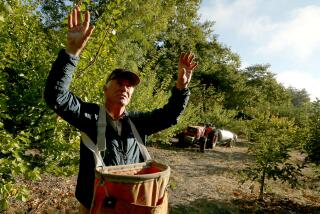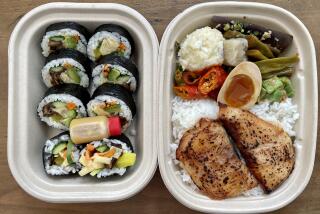Asian pears are in season; where to find them, plus 7 recipes

Apples, pears, persimmons, pomegranates, there is no shortage of fruits in the fall. But perhaps none sum up the sweet, honeyed flavor of the season as much as an Asian pear.
They start being harvested in late August, but they’re really coming into prime season now.
While we tend to lump them all into the same category, the differences among the popular varieties are at least as significant as those among the various apples.
Some late-season favorites include: Shinseiki, which has a very crisp texture and a flavor like honey, walnuts and flowers; 20th Century, another crisp pear that tastes like a sparkling combination of apples and citrus; Kosui, which has a vanilla undertone; and Chojuro, a buttery Japanese pear with a caramel sweetness.
Fruit expert David Karp particularly likes the Shinseiki, which he says has “a mild, sweet flavor and hard flesh. Brighter yellow Shinseikis are sweeter than pale or greenish fruits, which can be bland.”
He also likes the popular russet-skinned Hosui (as opposed to Kosui), which he says is less firm than Shinseiki, but much more juicy, sweet and aromatic — “a candy bar compared with a cool drink of water.”
He also advises that “the skin of Hosui and most other brown varieties is edible in theory, but thick and tough, so these fruits are best eaten peeled.”
According to Karp, though most of the current commercial offerings come from the Central Valley, many of the original Asian pear plantings in California were started by Japanese immigrants a century or more ago.
These were mainly located in the hills around Sacramento, and the hot days and cool nights do seem to give the fruit a chance to develop fuller flavor and sweetness. Look for them at farmers markets.
How to choose: Asian pears may feel hard as rocks, but they actually bruise quite easily. Russet varieties should be deep golden brown; smooth-skinned round fruit should be yellow, not green, and smooth-skinned pear-shaped fruit will be pale green.
How to store: Asian pears need to be refrigerated.
Are you a food geek? Follow me on Twitter @russ_parsons1
ALSO:
How to have an intimate lunch with Ludo Lefebvre at Trois Mec
Get everything you need for Oktoberfest at the Alpine Village Market
Grow, a new grocery store and deli, is opening in the DTLA Arts District
More to Read
Eat your way across L.A.
Get our weekly Tasting Notes newsletter for reviews, news and more.
You may occasionally receive promotional content from the Los Angeles Times.







